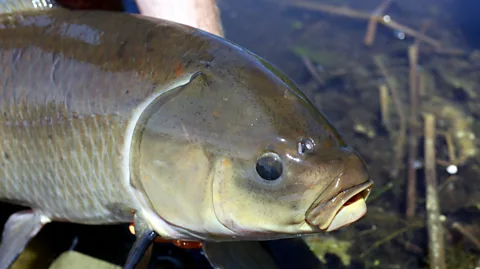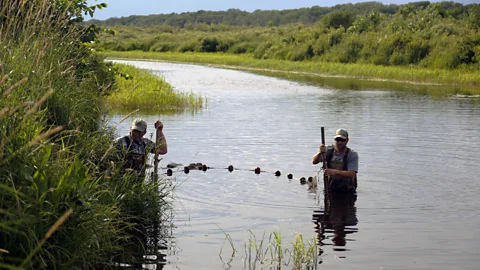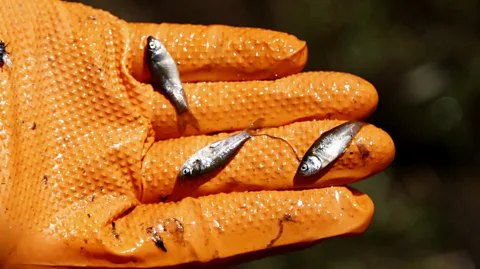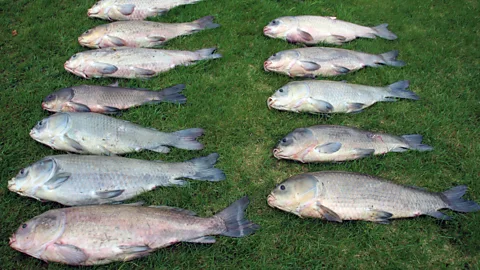Bigmouth buffalo: The mysterious fish that live for a century and don't decline with age
 Alec Lackmann
Alec LackmannRecent findings show bigmouth buffalo fish have perplexingly long lives and appear to get healthier as they age. But scientists are worried their population is about to crash.
If you ever find yourself on the shores of Minnesota's Rice Lake in May time, you may be able to spot swarms of large fish bodies mingling among the wild rice plants in water barely a few feet deep.
These are bigmouth buffalo fish, and they are the world's longest-lived freshwater fish. Some live for over 100 years.
Every year, these huge fish – which can weigh more than 50lb (23kg) – traverse through Rice River to spawn and reproduce in the lake. But the regularity of this spawning belies a hidden conservation concern: for more than six decades now, no new generations of young fish here have made it to adulthood.
Bigmouth buffalo have remained understudied for decades. In the last few years, however, scientists have begun to realise how unique these huge and incredibly long-lived fish truly are – even as they also uncover how imperilled they may be.
Bigmouth buffalo fish are native to North America and can be found from Southern Saskatchewan and Manitoba in Canada all the way down to Louisiana and Texas in the US. They're often viewed by the public and anglers as "rough fish" – a long-lived but non-scientific term used to imply that they're not particularly desirable – since they're not widely commercially fished and therefore not economically important.
It's this view of bigmouth buffalo that has long led them to be overlooked by scientists. Over the last five years, however, researchers have made a spate of new and surprising discoveries about them.
For one thing, individuals have been documented to reach up to 127 years of age, making them the world's longest-lived freshwater fish. They also don't seem to decline biologically with age. Most recently, researchers have realised that their stable population sizes over recent decades could be thanks to the fact that these old fish are not dying, even as they fail to produce young that survive into adulthood.
The few experts who study these fish worry that a severe drop in their population may be imminent, if not unavoidable. What's clear from the research so far is just how little we know about bigmouth buffalo, and how many unanswered questions remain.
"It's one of the oldest populations of animal in the world, and there's no management or protection of the species," says Alec Lackmann, a fish researcher at the University of Minnesota, Duluth, and one of the foremost experts on bigmouth buffalo fish and their ageing.
 Alec Lackmann
Alec LackmannLackmann led the research, published in a 2019 paper, which first discovered the centenarian lifespan of bigmouth buffalo in Minnesota. Prior to this, it was thought that the fish only lived to be about 26 years old. He later confirmed large numbers of centenarian individuals in other buffalo fish species in other parts of North America.
Lackmann's interest in these fish is a departure from his previous doctoral research, which involved studying non-biting midge flies in the Alaskan Arctic. Out of curiosity, he took some ichthyology (fish zoology) courses and learned how to determine the age of fish using the otolith, the stone-like structures found in the ears of most fish species. Otoliths grow rings over time, like those of a tree. By dissecting them into thin slices, scientists can count and analyse these rings and get an accurate look at a fish's age.
When he moved back to Minnesota, again following curiosity, Lackmann began dissecting the otoliths of the native species around him. "The first bigmouth buffalo I aged was almost 90 years old," he says. "I was like 'wow, holy smokes'… It was hard to believe at first."
The discovery led Lackmann to ask more questions about this strange but little-known fish. A couple of years later, he collaborated with experts in biological aging to assess known markers of stress and aging in bigmouth buffalo fish of various ages.
The researchers looked at immune cell ratios as well as the length of telomeres (a region DNA found at the end of a chromosome which limit the number of times a cell can divide), both indicators of biological ageing, and compared them with the otoliths rings showing the true age of the fish.
The research, published in 2021, only provided a snapshot of each fish's health at one moment in time, says Britt Heidinger, co-author of the paper and a biologist at North Dakota State University, who focuses on why organisms age at different rates. But it suggested that "we're really not seeing a decline with age in these organisms", she says.
Increased age in the fish was not associated with telomere shortening (a biological sign of ageing), as would normally be expected. Instead, it seemed to be linked with better immune functioning, including a decreased neutrophil-to-lymphocyte ratio – a change which suggests that these fish get better at handling bodily stress and see increased immunity as they age.
There's still a lot that's not known about how these fish manage to stay healthy in old age, says Heidinger, but it's possible that they might be maintaining their telomeres through an enzyme that prevents these from shortening. Unfortunately, however, telomeres can't tell us what the maximum lifespan of the bigmouth fish might be or give assurances that the trend of getting better with age will continue. After all, "ageing is a nonlinear process", Heidinger says.
 Alec Lackmann
Alec LackmannBut there is another puzzle unfolding in this recent research. Since such a high proportion of the fish sampled were exceptionally old, it begged another question: where are all the younger fish?
Lackmann and collaborators decided to sample fish ages in Minnesota's Rice Lake, while also annually observing spawning behaviours. In a recent paper, they reported that 99.7% of the fish they had sampled and aged – 389 out of 390 fish – were more than 50 years old. The median age was 79, meaning most of the fish in this population were born before the end of World War Two.
But what was really shocking was the fact that despite bigmouth buffalo fish successfully spawning every year around May, yielding many new young fish, by late summer all evidence of those young disappears. In fact, there hasn't been a successful generation of young fish there for more than 60 years, says Lackmann. "Every young fish that has survived after 1957 is a statistical outlier."
The researchers believe the reason for this dismal survival rate is likely predation by other native species such as pike. Pike also spawn in Rice Lake, just a little earlier in the year, so it's likely that young pike fish are predating on the baby buffalo fish, says Lackmann. The scientists theorise that the inordinately long lives of the fish are in fact an adaptation to the fact that their young only succeed once in a long while. But more research is needed to know for sure.
"To me, it's sort of like the chicken and the egg question," says Walt Ford, the refuge manager at Rice Lake National Wildlife Refuge and a co-author of the paper. On one hand, he says, they could have always been a long-lived species, and so the need to produce young might have never been urgent. On the other hand, maybe the difficulty of getting their young into adulthood has nudged the species to live longer and longer.
More like this:
• The secret of the world's richest underwater habitat
• The sushi delicacy threatened by climate change
• Tuvalu: The disappearing island nation recreating itself in the metaverse
Regardless of the reason, no one knows how anomalous the current 60-year gap is, or even what the maximum lifespan of these fish might be. The Rice Lake population is not isolated, so it's possible it mixes with other populations from elsewhere. Most, if not all, populations of bigmouth buffalo fish studied so far appear similarly skewed toward very old fish – an indication that this situation might be widespread. With the current generation getting ever older, these populations could be vulnerable.
"That's the really scary thing about [Lackmann's new] paper," says Heidinger – the realisation that high levels of adult mortality "could wipe that population out". Currently, no one knows how many bigmouth buffalo fish there are, or how many distinct populations exist, adds Lackmann.
Adult bigmouth buffalo fish have no adult predators – except humans. While they are listed as a species of special concern in Canada, and as endangered in Pennsylvania, throughout the rest of the US little to no protections are in place for them. They are popular bowfishing targets, and in Minnesota there are no limits to how many bowfishers are allowed to kill at a time, says Ford. "Oftentimes we'll find piles of them dumped a short distance away," he says.
 Alec Lackmann
Alec LackmannProtections and awareness are key, says Lackmann. People will often mistake bigmouth buffalo fish for invasive carp species and think they're helping the ecosystem by removing them. Ironically, bigmouth buffalo are native species that can help protect these ecosystems from their invasive counterparts, he says.
Knowing what we know now – that these fish are incredibly old with young that are struggling to survive – Ford says he hopes states like Minnesota will soon put much needed limits on their fishing, while scientists learn more and figure out how to help this species. "We need to hurry our research on this," he says. "It seems urgent."
So long as bigmouth buffalo fish are not widely considered an important or interesting species, however, it will be hard to conduct that research. Bigmouth buffalo are also not considered ecologically important, which contributes to them being overlooked. It's a cycle: bigmouth buffalo are ignored, no funding goes toward their protection or research, and then the dearth of research prevents us from seeing their importance and vulnerabilities, so they stay ignored. A similar story is seen in many other overlooked fish species – new research has only just started to reveal the previously unknown complexities of other "rough fish" like quillback suckers, bowfins and redhorse suckers.
Carbon Count
The emissions from travel it took to report this story were 0kg CO2. The digital emissions from this story are an estimated 1.2g to 3.6g CO2 per page view. Find out more about how we calculated this figure here.
There's still so much to learn before experts can know how to help bigmouth buffalo. "A lot of the elementary biology of bigmouth buffalo is not known," says Eva Enders, a fish ecologist at the National Institute of Scientific Research in Québec City, Canada. "We have very little understanding about their metabolic rate, or what temperature ranges they can tolerate – all really important variables to know if you want to do predictions or modelling of the species distribution with climate change."
For the Minnesota population specifically, Lackmann adds, scientists don't even know where they migrate from, nor where they spend the rest of the year before and after spawning.
One theory for why baby fish are having trouble making it to adulthood is that there could be some kind of habitat disruption through dam construction, says Lackmann. If that's the case, whether they can figure out what the bottleneck is, and how to reverse it in time, remains to be seen.
If researchers and conservationists don’t work fast enough, we risk losing a species with fascinating and potentially unique biological secrets for staving off ageing. It's not clear whether there are decades left on the clock or just a few years, but time is ticking.
--
For essential climate news and hopeful developments to your inbox, sign up to the Future Earth newsletter, while The Essential List delivers a handpicked selection of features and insights twice a week.
